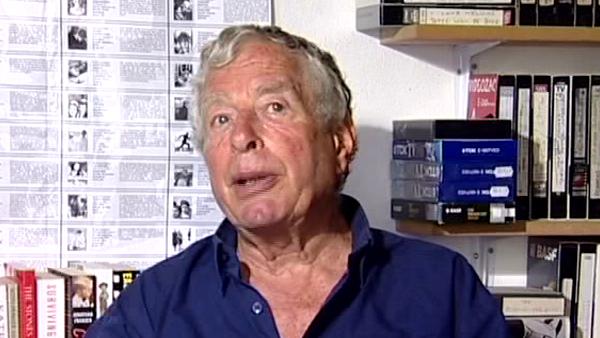NEXT STORY

The Girl in Black: The rescue scene and English tourists
RELATED STORIES

NEXT STORY

The Girl in Black: The rescue scene and English tourists
RELATED STORIES


|
Views | Duration | |
|---|---|---|---|
| 81. Tom Jones: The editing and Tony Richardson's... | 172 | 05:04 | |
| 82. The end of Woodfall | 77 | 01:41 | |
| 83. Tom Jones: Good for the careers of the crew | 86 | 00:56 | |
| 84. Artists and chemists | 49 | 03:01 | |
| 85. Meeting Michael Cacoyannis for the first time | 108 | 01:39 | |
| 86. Michael Cacoyannis' directorial style | 111 | 04:42 | |
| 87. The Girl in Black: De-blimping an Arriflex | 69 | 03:15 | |
| 88. The Girl in Black: Post-synching and hand-holding | 49 | 01:38 | |
| 89. The Girl in Black: The rescue scene and English... | 54 | 01:02 | |
| 90. The Girl in Black: Working with simple technology | 55 | 03:54 |


So I'd asked for an Arriflex to film The Girl in Black and what arrived was the first brand new blimped Arriflex. It didn't exist before. And it was like a huge trunk, and it was like a monster. A huge camera. To me it was huge. It was relatively small, actually, for a blimped camera, but I said, 'I can't operate that!' So we deconstructed it. We searched Athens for somebody who had an old Arriflex because we needed a hood, which is different in the blimp, and a door which is different, and the motor is different. So we needed three items to turn the camera back into a hand-holdable camera. Then the film is filmed entirely with that camera. That's to say, entirely without sound. There isn't any sound, there isn't any dialogue, there isn't any guide track, it's filmed completely mute, and that was perfectly okay with Cacoyannis and perfectly okay with the actors, because they were extremely well used to post-synching their dialogue. So that didn't cause any problems whatsoever, and we ended up with a very manoeuvrable, light outfit. In Girl in Black there are two, or maybe three, hand-held sequences where there is a fight outside the house where she lives, the heroine, lives and then there's the main incident in the film where a lot of children are drowned by accident involving the main male character. And, for those sequences I used hand-holding, again, being very careful to start the hand-holding at the moment when the action turns violent, and to stop the hand-holding at the moment when the action stops being violent, and that is very effective way of doing it.
Born in Germany, cinematographer Walter Lassally (1926-2017) was best known for his Oscar-winning work on 'Zorba the Greek'. He was greatly respected in the film industry for his ability to take the best of his work in one area and apply it to another, from mainstream to international art films to documentary. He was associated with the Free Cinema movement in the 1950s, and the British New Wave in the early 1960s. In 1987 he published his autobiography called 'Itinerant Cameraman'.
Title: "The Girl in Black": Post-synching and hand-holding
Listeners: Peter Bowen
Peter Bowen is a Canadian who came to Europe to study and never got round to heading back home. He did his undergraduate work at Carleton University (in Biology) in Ottawa, and then did graduate work at the University of Western Ontario (in Zoology). After completing his doctorate at Oxford (in the Department of Zoology), followed with a year of postdoc at the University of London, he moved to the University's newly-established Audio-Visual Centre (under the direction of Michael Clarke) where he spent four years in production (of primarily science programs) and began to teach film. In 1974 Bowden became Director of the new Audio-Visual Centre at the University of Warwick, which was then in the process of introducing film studies into the curriculum and where his interest in the academic study of film was promoted and encouraged by scholars such as Victor Perkins, Robin Wood, and Richard Dyer. In 1983, his partner and he moved to Greece, and the following year he began to teach for the University of Maryland (European Division), for which he has taught (and continues to teach) biology and film courses in Crete, Bosnia, and the Middle East.
Tags: sound, actors, mute, post-synch, action
Duration: 1 minute, 39 seconds
Date story recorded: June 2004
Date story went live: 24 January 2008